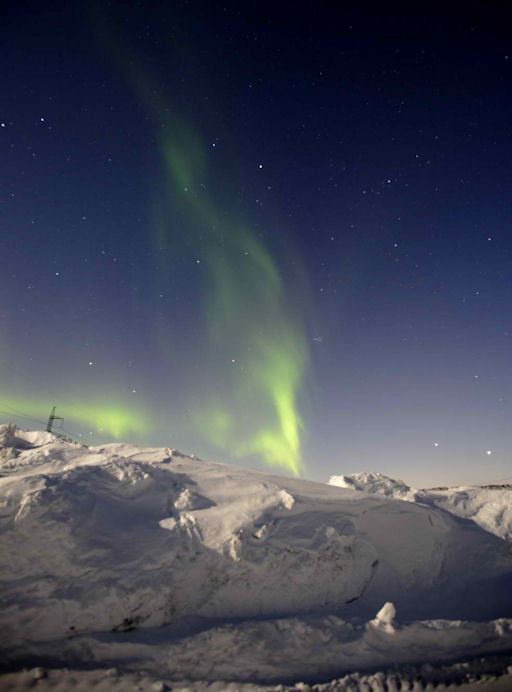They came from outer space--and you can have one! Genuine meteorites are now on sale in the Space Weather Store. | | |
CME IMPACT: A coronal mass ejection (CME) hit Earth's magnetic field on March 8th around 1100 UT. The impact was weaker than expected, sparking only a mild (Kp=5) geomagnetic storm. However, the storm could intensify in the hours ahead depending on electromagnetic conditions in the wake of the CME. High-latitude sky watchers should be alert for auroras. Aurora alerts: text, phone.
Giovanni Cappelli sends this picture from the tundra east of Murmansk, Russia:

"We were in the tundra waiting for the CME," says Cappelli. "The auroras were better than expected this time. This photo resembled green fire shooting up from the snow "
more images: from Pavel Kantsurov of Norilsk, Russia; from Aleksander Chernucho of Kola peninsula, Russia, Mt. Khibiny; from Chad Blakley of Aurora Sky Station, Abisko National Park, Sweden; from Timo Newton-Syms of Ruka, Finland; from Timo Veijalainen of Sodankylä, Finland;
HUGE SUNSPOT: Active sunspot AR1429 continues to grow. It is now more than seven times wider than Earth, which makes it an easy target for backyard solar telescopes. In fact, yesterday, David Tremblay of Alto, New Mexico, saw it using no telescope at all. All he needed was a dust storm:

"The dust blowing from Tularosa Basin was so dense, we could observe the sun with the naked eye--and there was sunspot AR1429. Wow!" says Tremblay.
The behemoth spot has unleashed four strong flares since it emerged on March 2nd, including the X5-class eruption of March 7th. More could be in the offing. The active region has a "beta-gamma-delta" class magnetic field that harbors energy for additional X-class eruptions. Solar flare alerts: text, phone.
more images: from Jett Aguilar of Quezon City, Philippines; from James Kevin Ty of Manila, Philippines; from Harald Paleske of Langendorf b. Weißenfels, Germany; from Rogerio Marcon of Campinas SP Brasil; from Monika Landy-Gyebnar of Veszprem, Hungary; from Ron Wayman of Tampa Florida; from John Stetson of Falmouth, Maine; from Robert Lowton of Whaley Bridge, Peak District, United Kingdom; from José Geraldo Mattos of Florianópolis, Jurerê Internacional, Santa Catarina, Brasil; from Matthew Wastell of Brisbane, Australia; from Kiss Csongor of Derecske, Hungary
February 2012 Aurora Gallery
[previous Februaries: 2011, 2010, 2009, 2008, 2007, 2006, 2004, 2003, 2002]

